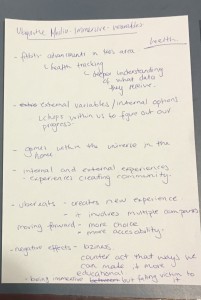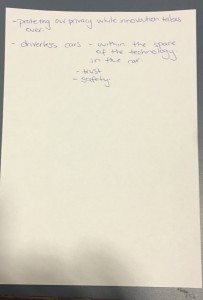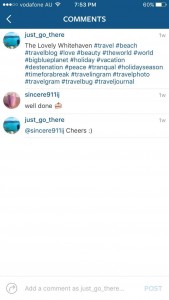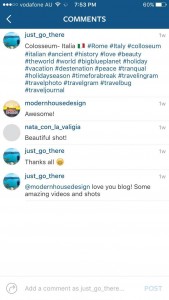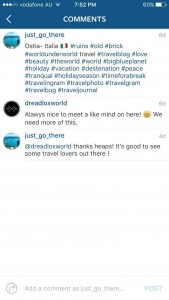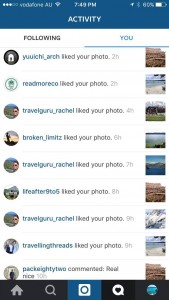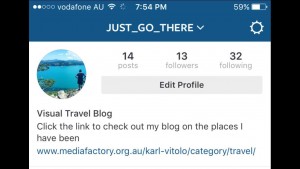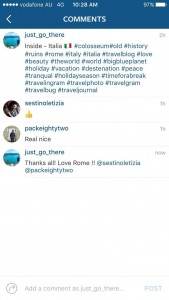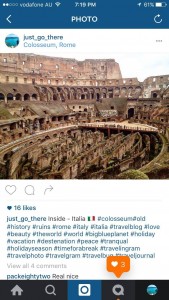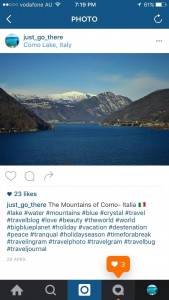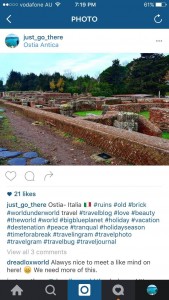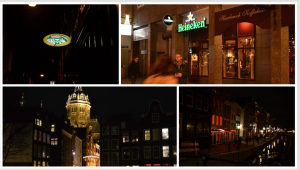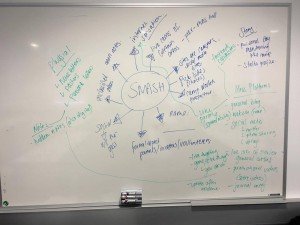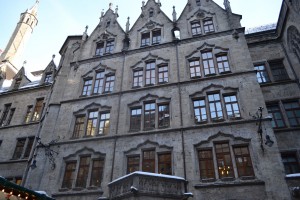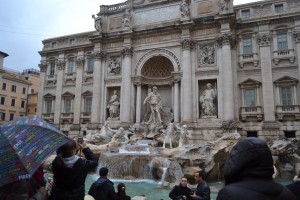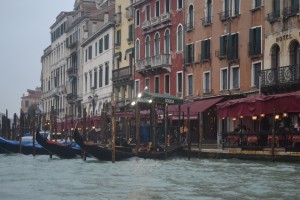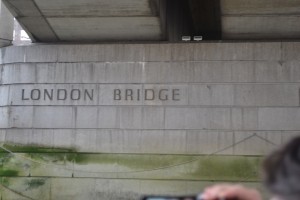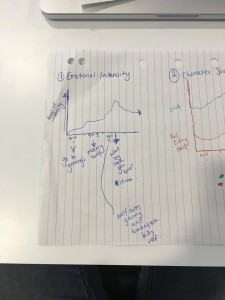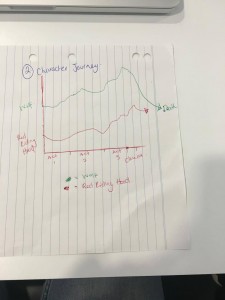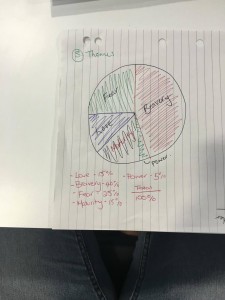When I began the studio, I had one clear goal in my sights and that was to create something I haven’t created before, go against the norm and challenge the typical norms of what fashion films are. In saying this my knowledge of what fashion film was, was quite scarce. However, after a few classes my understating started to become more clear and ideas of my own started to form. The progressiveness of the course was very helpful in determining what the final film would be like. We developed our skills week by week and although at times it seemed repetitive the constant reassurance made me more confident in my own skills that I acquired before coming into the studio. The biggest aspect of learning I did throughout the course was to effectively work in a team and be collaborative. My experiences up until now have always been in a group environment but we were always working on our own films and vision. However, in this instance we had to develop, implement and execute an idea as two minds. This I think overall worked effectively. Although, knowing how Claudia worked creatively and physically was a great advantage and it helped us further our working relationship even more.
Aside from the collaboration development I think another element of learning for me was understating the fashion film medium itself. My first thoughts were simply what you see on TV; commercialised brands trying to sell clothes. However, I have progressively learnt that it is so much more than that. Fashion film encompasses a huge amount of detail. It can be a documentary, a narrative, a feel, a look, a smell, the possibilities are endless. Knowing this we as a group and as individuals brought our background in film making and this new-found knowledge to produce an avant-garde piece of work that defied the common tropes surrounding fashion film.
Creating this film was truly a great experience. From the start, me and Claudia were very clear that we wanted it to be bold and to tell a story that actively involved the audience to think and reflect rather than just mindlessly consume. The most successful aspect of the film was our dedication to the project. After three years of producing by the book media and film we wanted to let our visions fly, particularly with colour, lighting and costuming. We have learnt and were encouraged again that pre-production was one of the most important aspects of filmmaking and I think this time we listened. I believe that the time we put in to understating our story as filmmakers and making sure that every action had purpose and meaning paid off in the end. We were both able to go into our shoot day confidently knowing what we wanted the film to look, feel and sound like. In addition, the organisation of props, cast, crew and lighting were very well planned and executed. I owe a huge amount of appreciation to Claudia as she did take charge of the project and was very efficient in getting jobs done. Her dedication to the creative vision was what helped get the project across the line.
When it came to the day of the shoot we felt calm but still a bit nervous as we wanted to get the perfect shots as we pictured them in our heads. The organisation of the day was well planned and we stuck to schedule as much as possible. As with most film projects there are always hiccups and the biggest thing I can take away from the shoot day was to have budgeted more time to get the shoot done. The few extra hours would have ensured that we got the perfect take of each shot. This is not to say that we didn’t get good takes because we did but for future this is a good learning curve. That if you want the shoot done to 100% satisfaction budget enough time. I think the reason we didn’t pick this up earlier was because we have always had ample time to get shoots done in the past so we thought we would have enough time. Although it was a one day shoot on a Sunday our jobs lasted all weekend but the professionalism of the nine plus cast and crew was a huge help. Everybody was on time and ready to work and I think this was one of the reasons it ran so smoothly.
Thanks to the nature of the film which was minimal shots the editing process was not that taxing. The hardest part was ensuring that our sound and atmos matched the story we were trying to tell. Again, thanks to the creative and perceptive eye of my team mate Claudia, we could troubleshoot through problems in the edit suite and produce a final film we were both proud of. Not only were we proud but it personally met my goal at the start of semester to create something I haven’t done before and a piece of work that questions the norms. I think the audience is captivated by the story and the experience of the film and they can consider what happened even after it is finished.
Overall, I think my performance in the studio has been personally good. I love how I could just be a bit creative and we were left to our own devices to create. Not many times in university are you allowed to just be creative and I think it has paid off because this was one of the best studios I have been a part of. I feel I have been an asset to my team logistically and creatively but I think I have also understood where my strengths lie. By understanding this, I have let others delve into their own strengths and together we have made a film we are proud of. The constant support from Christina and the other teachers throughout the course has been very helpful because they were not intrusive but were there when we needed help. Overall, a great experience and learning curve for myself as filmmaker and as a team player.
Project Brief 3 Reflection…
The pitch went well in my opinion in determining the aspects of our ideas that we have not thought of yet. I think technically the pitch was a great active discussion between us and the panel. I think that we benefited from the fact that we have a strong and definitive idea and comment of what we want to achieve. The main aspect of the project was to be able to receive constructive feedback and potentially apply it to our film. The feedback we received in particular about the fact that we are comparing burnt toast to being different in fashion I believe didn’t really help as I think the toast is more metaphorical rather than literal. The literal aspect is more to do with the cutting of her strings. However, the comment regarding the kitchen being more simple was something that made us think that we should dull down the set we have.
Another great piece of feedback we received was that we could potentially use a dancer to play our main protagonist not to dance but have a person that understands their body and is able to portray the doll like character we want to get across. Another idea that came from the feedback session is the idea of music that we are going to have. Although we haven’t thought about the sound a lot the information we got regarding the atmos sound being moved to potentially soft music or adding in sound effects of a domestic environment I think is something we could take on board as it will add a more relatable effect and will strengthen the contrast of the piece of clothing to the environment. Overall, the feedback was mostly helpful and has allowed us to think about parts of the film that we have not thought of yet or that we have not looked at in that way and will help us build a stronger story.
Progress Update Brief 2…
Through this process I have found that the person I am working with brings out a different eye to me. Claudia makes me push the boundaries in what is the norm for fashion film because that is what you need to do. This is the biggest thing we have learned. It is in actual fact harder to make a good fashion film than a good short film that has structure, story and well thought out dialogues. Fashion can be like this but in order to communicate it you need to capture that in a smaller amount of time. In addition an audience for a fashion film has a shorter attention span than that of a short film so you need to make them understand your concept in a shorter time.
This in mind we decided to go with the commercial style that we came up with. I believe that it was a great way to get us into the more abstract and adventurous style of filmmaking and gave us the freedom to express and play with things like focus and quick editing. This was evident when we went to the edit suite. Whilst we were editing the film we were finding it difficult to pin point the exact tone and motion we wanted the film to have, so we decided that before we took on the actual film editing we decided to do the sound editing first. This proved to be a smart and efficient move as we were able to structure the shots and cut on beats. It allowed us to cull a lot of the footage that didn’t fit the aesthetic of the film and truly delve into the best parts of the clips. These were in the little details such as a focus pull, eye movement, turn of the head and so on. By taking an emotional approach to the film you start to feel rather than observe and that makes for a more thorough and thought out final piece of work.
I think in terms of our final fashion film it truly depends on the style of garment or garments that we decide to use. I say this because I believe the feel, texture, colour and structure of the garment decides the direction the film takes. You need to understand the way the garment makes you feel in order to portray it in film. I think if we take this into consideration and decide on audio before we edit we will be able to make a great and thoughtful final film. This was fluid with the feedback received in class from Christina and classmates. They commented on the preciseness and efficivness of the editing. Which I think we can play to as a strength in the final film. Also the variance of the shots was what allowed us to get the variance in focus for the audience and this was commented on as well. It played to the pace and tempo of the music which was a great advantage. Overall, from this collaborative process I am looking forward to co-creating, editing and previewing our final project.
Camera in Fashion…
This week in the studio we had Bryan come in to walk us through the use of camera. It was like an informative crash course. Although I have gone through nearly three years of film school now it is always good to have a refresher and you can never stop learning. You learn something new every time you look at a camera and sometimes getting things explained differently is a good thing.
I think however we were itching to just film something and start seeing how fabrics move. Claudia and I concluded in the end to work on a shoot that Claudia had already going on this week. We think it will be good practice for our final film and will get us back into the swing of things. We also made some headway in deciding what we wanted for our final film. We were able to start brainstorming some ideas of who and what we want to work on. We have decided that we truly want this to be a strong evidence of our skills and creativity. We want to produce something that is strong in both areas and can use to market ourselves to employers post uni. I am excited to get into some editing next week of the short clip and see what everyone in the class comes up with.
Wants and Desires …
I put down the to be apart of the More Than Fabrics studio because in all honesty it was the most interning and different to what I have done in my now 3 years of university. I wanted to make sure that for my final semester I was doing something I enjoyed over something I had to do. As fashion has always been of interest to me I was interested to see how fashion films worked and how I could make one. The main skill I want to gain from completing this course is to be able to create a piece of work that I could actually use to pitch myself and my personal brand to an employer. I don’t want to really make something like a documentary as I want to exercise my skills in film making and go beyond the common rules of filmmaking. I want to be able to create a marketable, unique and stylistic piece of work that catches peoples attention.
At this point of my degree I want to work with similar minded people who are willing to actually apply themselves and understand the need for marketable skills in the industry. Not everything can be the next indie film that is going to get you nowhere!! I suppose my main goal from finishing this course and my university degree as a whole is A, to prove to myself that I could actually do it and B, that I have a varied skill set that will get me work in doing what I love. I can already feel this class is going to help me achieve that.
Aesthetically Pleasing …
The images I have chosen for this assignment reflect my strongest passions when it comes to filmmaking and just being a creative person in general. These are, vibrancy but not pretension and insightful messages without being tasteless. I am not going to profess to being the most avant-garde and edgy intellectual when it comes to fashion but there is something about being able to take high fashion and commercialised fashion and make it unique. This is where my interest lies but as we all know you are not able to create without influence or inspiration of some sort.
“There is something about fashion that can make people very nervous” (Wintour, 2009) A statement that rings true to a lot of people but it is how you tackle this will determine how you create. It is with this statement in mind that I chose my images. All my images have a reoccurring use of strong contrasting colours whether they are calm or bold and fiery. For me colour in meek or dark backgrounds is something that demands attention and really underpins a strong image. Also the varying use of somber, eerie and intense directional lighting is rampant within the images and they play an integral role to the understanding of place within the image, not only for the actual models or actors but for the viewer and audience alike. Something different, something bold, something that transports you is evidence of a strong piece of fashion work that doesn’t fall victim to the nervousness that surrounds the fashion industry.
References:
The September Issue. (2009). [DVD] USA: R.J. Cutler
To the Future…
Howard Gardener Five Minds for the Future explores the necessity of the five minds that humans will need to adapt in order for the race and human being as whole to survive. These minds each differ from each other and ultimately combined together are a whole well rounded person. These future minds are as outlined by Gardener:
- The Disciplined Mind- mastery of major schools of thought and of at least one professional craft.
- The Synthesising Mind- ability to integrate ideas from different disciplines or spheres into a coherent whole and to communicate that integration to others.
- The Creating Mind- capacity to uncover and clarify new problems, questions and phenomena.
- The Respectful Mind- awareness of the and appreciation for differences among human beings.
- The Ethical Mind- fulfilment of one’s responsibilities as a worker and a citizen.
These minds are the cornerstone of the future human being and it is largely influenced by the willingness and necessity of learning and education, whether this be via traditional forms of education. Or via other methods such as peers and parents and of course the media. The media is a major and highly influential driving force within todays society but as it is ever going at such a rapid rate it can only influence our minds more and more. Gardner’s approach in my opinion is understandable as I feel that these ‘minds’ are what people of today are trying to achieve but his thoughts on the way education is being utilised to achieve these mind goals I believe are sound. That we should be educating our students in all areas not just academic specific ones. Allowing them to be tolerant, scientific, artistic, respectful and conflict resolvers will ensure that these five minds are achieved and the future image of a human is painted.
Howard Gardner, 2007, ‘Minds Viewed Globally: A Personal Introduction’ in Five Minds For the Future, Harvard Business School Press, Boston, ch.1.
Tick Tock Tick Tock…
This weeks reading was focused around the idea of time, work and how technology plays into the whole equation. It highlights the way the innovators of the time thought that technology would take off and predict the way it would be like in todays age. They also believed that we as humans would use technology in a way that made our lives easier and allowed us more of a work life balance by reducing the hours that we worked. However, Wajcman goes into great detail of how technology has in fact done the opposite of what we thought it may have.
The writer highlights how technology has sped up the way of life due to its accessibility, convenience and unrestricted time constraints. Upon completing this reading I can understand where the writer is coming from. The fact that technology was invented to make our lives easier which in a way it has as we have the ability to do so much more and enables us to multitask with precision but on the flip side it has blurred the lines between work and life time. We are now consuming and working with media in a supposed ‘down time’. Although we have not reduced in work hours we have allowed it to filter into our personal lives but this did raise a question in my own mind. Has the description of personal life changed? Although we consume media in our downtime a lot of it is aimed at social and easily/relaxed consumption such as Facebook and online shopping. This differs from the email which includes actual work. Overall, I enjoyed the reading but thought it did focus on the way we use technology for work and didn’t include enough the type of activites we consume.
Judy Wajcman, 2015, ‘Finding Time in a Digital Age’ in Pressed for Time: The Acceleration of Life in Digital Capitalism, ch.7.
The Right Mindset…
Cal Newport’s The Clarity of Craftsmanship was enlightening to read. It really focused in on the age old question of whether or not you are truly sufficed in what you do ? It did not answer the question however, but it did provide one with the tools to have a successful career and the passion for that comes later. It forces you to focus on the craft rather than what the craft can give to you. By comparing two mindsets, ‘the craftsman mindset’ and ‘the passion mindset’ Newport highlights the key differences between passion and making passion happen.
The craftsman mindset focuses on becoming so good at your craft that people can’t ignore you. It suggests that if your continuously bettering yourself within your specific field then you will succeed. His uses of famous comedian Steve Martin highlights the usefulness of this mindset. He explains that Steve did not try to recreate comedy in the way it had already been done but rather worked and reshaped his own style over a decade suffering from chronic anxiety attacks to even begin his career but when he did he was the most successful.
The writer compares this to the mindset we mostly take as humans. Whether or not this is due to our laziness but the passion mindset is the mindset that the craft has something to offer you. That if you have a passion for it then it will come to you.
I really resonate with this reading because in the media industry particularly one needs to be focused and always on top of the craft because if your not you will fall behind. Also if you sit there waiting for that magic and lucky opportunity to come along it will only lead to unhappiness. One has to work and work to perfect their skills so employers and colleagues can’t look away from you.
Cal Newport, 2012, ‘The Clarity of the Craftsman’ in So Good They Can’t Ignore You: Why Skills Trump Passion in the Quest for Work, NY Business Plus, ch.4.
Work Work Work…
Upon completing the reading for this week I felt a sense of fear but excitement. The fear I believe directly correlates to the realities of the media industry. The author speaks of the low, unfair and frankly unethical pay that media freelancers in particular recieve for their hard work. But I am also excited to be part of such a talked about and current industry. By examining relations between formal and informal economies, Lobato and Thomas offer a refreshingly fresh and important way understanding all aspects of media from production to even media history.
The books comments on the media worker being overused and cheated due to the eagerness of young hopefuls. This really resonates with me particularly because of the generation I am apart of. We are a generation who want everything now and the idea of working up the food chain so called doesn’t sit well with a lot of us. That is why the informal economy of freelancing and working for yourself is becoming so popular. However, for the others who believe that hard work will get you far are being taken advantage of. Their aspirations and hard work are being exploited and we are getting drained too young.
Overall, I didn’t love this reading but was able to connect with a few aspects and issues it was dealing with.
Ramon Lobato and Julian Thomas, 2015, ‘Work’ in The Informal Media Economy, Polity Press, Cambridge UK, ch.3.
360 Film Annotated…
Bibliography
1. http://www.thedrum.com/news/2016/07/20/going-360-jacob-s-creek-invites-wine-lovers-their-vineyards
This article is based around the use of 360 degree film in advertising for companies and business. The reason it interested me was how it was used with a local company to Australia. This showing that 360 film and the VR experience is becoming prevalent within the community we are immediately impacted by and also the outreach it has globally. The crux of the article highlights the possibilities that Jacobs Creek had when creating the experience. They were able to release the videos over six parts. Each part focusing on a different experience
“At each point in the experience, on screen graphics will offer the viewer information about the varietals, history, and location in relation to the wine in the bottle, adding a new level of depth and flavour.”
By narrowing in on the particulars of the separate wines and their magic it really immersed the viewer into the world of Jacobs Creek. This highlights how this new innovative technique is being used not only to advertise products but to actually take people on a journey with the product. To feel it experience it even if they are thousands of miles a way.
The immersive nature and accessibility of the technique and product allow complained to show off themselves in ways that would have once never been possible but now they are able to simply use platforms such as Facebook and YouTube to market themselves and give there consumers and experience that other companies may not offer.
2. http://www.int-arch-photogramm-remote-sens-spatial-inf-sci.net/XXXVIII-5-W16/69/2011/isprsarchives-XXXVIII-5-W16-69-2011.pdf (Peer Review)
This paper is highlighting the use of 360 degree film in the way we experience place and in a roundabout way the art form of the VR immersive experience. The paper focuses on bringing to life a ruined church and allowing people to experience how it may have been when it was standing. Through the use of historical photographs, green screen and design the writer was able to ascertain how the church may have looked and felt. However, the purpose of the experiment I suppose was to allow people to actually understand the tonality of the church in the time it was active. The writers particular and major interest of 3D animation and film led them to the idea of 360 film as tool to launch the report into an innovative new platform of experience. The report actually goes into great detail of the mechanics of 360 film and the way it works however understands the story of what the writer is trying to portray.
The idea of the church highlights the meeting of history and new media and education and new media. Allowing humans to physically exist in a virtual world that at one point or another existed. The conclusion of he report highlighted not only the technical requirements to actually prepare a 360 immersive experience but the way the audience guided the story within their own minds. By giving this agency to the audience it highlights the importance of reality and the seamless feeling that needs to be present for an audience when creating it.
3. http://m.thenational.ae/arts-life/film/dubai-filmmaker-clyde-desouza-explores-the-reality-of-virtual-cinemas-great-potential
4. http://www.outsideonline.com/2101386/rex-ready-fly
The New World…
This weeks reading centralised around the idea of E&M (Entertainment and Media Industries) it looked at the geographical nature of the industry and the way it is evolving and remoulding to new wave ideals. The aspect of the reading I found to be most insightful was the idea of the location specific markets. We live in a world of global companies and products that are accessible by a lot of the western civilisation particularly. However, the reading highlighted the importance of local content and how it had the ability to define the particular E&M industries within the particular countries.
Although some of these ideas may seem contrary to the outcomes of our course I believe it is important to understand that we must look locally as well as globally and take into consideration sociatile preferences. The reading also talked about the rising prevalence of the aggregator and how companies can use this idea to benefit them. The importance of our interests and networks within one space is becoming extremely important especially to the younger generation as they have access to so many options on the web. By opening up to this idea even traditional media companies can continue to thrive by getting information to people in a more digital friendly way.
The final idea I took from this reading and found rather interesting was the use of E&M in advertising. It spoke of the idea that new media platform are opening up avenues for companies to use that is alternative to the traditional “big idea” companies. The data being collected is more specific and tailored. This is interesting in that what is it that we can expect for future advertising with traditional companies needing to work harder to win business if there are other cheaper and more definitive options such as Google and Facebook? Overall I like this reading and the messages and ideas it explored it is starting to make more sense the idea of the future of new media.
Astrid and Ubiquitous Media…
In the lecture this week we had guest lecturer Astrid from ABC R&D. I found her talk insightful and exciting to see the way that the media landscape and humans interaction with media is shaping up in the current time. She spoke of new media that I haven’t really heard off such as the holographic experiences and the smart fridges. It gave me some really interesting ideas and thoughts when it came to approaching Media 6. When we broke out into separate groups we brainstormed further into the three headings and there sub headings.
My group had a – immersive and wearable’s. This is media that is able to be experienced all around. One becomes a part of the medium rather than simply consuming it. As per the attached pictures they were rather interesting in deciphering new ideas such as advancements to health and allowing people to understand the data they are receiving. In addition we thought of all round experiences with driverless cars allowing the monotony of driving to become an interactive and technological journey. We also weighed in on the risk of these types of media such as laziness and losing our sense of humanity to the media machine. We emphasised the point that we must move forward but still remember the foundations of who we are as humans.
The Revolution…
Upon completing the reading for this week there were several details that I was left perplexing over. Who are we? Where are we? but most importantly where are we going? Technology as a transport system and convenience tool has been rampant and rapidly growing for several years but as humans we have, whether we felt it or not had some form of control over it. As a result of this reading this may not be the case in the not so distant future. Schwab comments on the various ways that technology is evolving and the completely unimaginable tasks it can preform from 3D printing to even assigning treatment for cancer sufferers. It is with out a doubt that the human race particularly the new generations depend deeply on the speed and convenience of the heights of the technological and digital realms.
However, have we thought of how we as humans, not machines are going to evolve with it. His comments on these new technologies, are supported with a an in depth caution, that we need to continue to be the consumers and actually not become consumed. Schwab’s particular comments on the effect that the cloud and the digital world have on our jobs interested me the most. It made me feel almost insecure that we will soon essentially relinquish our employee rights for ease of access and be happy to willingly do so.
Overall, the comments that Schwab makes about the impending industrial revolution are not cynical in anyway but rather cautionary to the way we as humans interact with it. That we should not lose our sense of self and humanity at the whim of the now traditional computer.
- Extracts from Klaus Schwab, 2016, The Fourth Industrial Revolution (World Economic Forum), pp.14-26, 47-50, 67-73, 91-104.
Assessment 4 / Story Lab Reflection…
Throughout the process of completing our last Assessment project for Story Lab I can confidently say that I have learned a lot about story and the stories that can be found in everyday events. In addition the complexity and depth involved in creating a transmedia story is far greater than I could have ever anticipated. It is based largely on events and how those events effect character, motive and the most important the audience. For the audience is the driving factor behind a lot of new media production and platform. The idea of agency has also played a huge integral role in changing my view on how a story can be told. The days of one media text giving the whole story to the audience is coming to an end and the age of the audience being the deciding factor of a stories end has begun.
When thinking of the idea for Classified Luke and I worked off the idea Luke created for our short story at the start of semester. We began brainstorming ways in which we would be able to elaborate on the story and make it truly enticing. As a result of this we broke down our story into dot points. By doing this it allowed us to get a clearer picture of what we were trying to say and how we could use different aspects of the text as different entry points to introduce new and different media platforms. Once this process was done it made it much simpler for us to start planning out our release dates.
When developing the content for the story Luke and I both agreed that we wanted to release it over a number of weeks and mostly on the non-digital platform. The reason we went hard copy was because it fit with the aesthetic of the story. It is truly underworld and secretive so putting too much information on the web would have made it to accessible to anybody. However, the idea of having the conspiracy theorist/hate blog online was perfect because in a real life situation that is exactly where you would find it. On an amateur unknown blog.
I believe that Luke and I worked great together. I think we definitely fulfilled the requirements we set ourselves in our collaborative contract. We worked fairly at all times ensuring no one person was left to do all the work and also hard to stick to the deadlines we set ourselves to make sure we released evidence on time. Our final product I am very proud of as it shows of our skills and strengths as well as including the aspects of media that we were less confident with. Although it doesn’t allow the audience to decide the way the story concludes it allows them to be involved the whole way through. To find the clues and create their own story lines in their head. We also collaboratively decided to leave the story open-ended to what happens to the criminals to keep the mystery of it alive. Overall, I was extremely happy with the content we created and the way we worked as a team to get us there in addition to the helpful information we learnt prior to beginning the project.
Assessment Task 3: Collaborative Hypermedia Story & Reflection
Assessment 3 Networked Media 2016
Jordan Williams, Andrea Blake, Hannah Tepoorten, Karl Vitolo
Muggle in Melbourne
Link to Photo Map (Front Page)- http://s3583984.wix.com/muggleinmelbourne
Links to All Pages:
Airport- http://s3583984.wix.com/muggleinmelbourne#!airport/aar78
Bar- http://s3583984.wix.com/muggleinmelbourne#!bar/qzkzu
Cafes- http://s3583984.wix.com/muggleinmelbourne#!cafe/lq5lj
Laneways- http://s3583984.wix.com/muggleinmelbourne#!laneways/idqq4
Shopping Malls- http://s3583984.wix.com/muggleinmelbourne#!shopping/qwqf4
Swanston Street- http://s3583984.wix.com/muggleinmelbourne#!swanston-st/ot7dq
Zoo- http://s3583984.wix.com/muggleinmelbourne#!zoo/ji904
Trams- http://s3583984.wix.com/muggleinmelbourne#!trams/z1w0l
Myki- http://s3583984.wix.com/muggleinmelbourne#!myki/y80j8
Kebab Stops- http://s3583984.wix.com/muggleinmelbourne#!kebab/k0vru
Trains- http://s3583984.wix.com/muggleinmelbourne#!train-station/k6ceu
Buskers- http://s3583984.wix.com/muggleinmelbourne#!buskers/n1smg
ACMI- http://s3583984.wix.com/muggleinmelbourne#!acmi/fmes3
State Library- http://s3583984.wix.com/muggleinmelbourne#!library/gfydk
Food Court- http://s3583984.wix.com/muggleinmelbourne#!foodcourt/cbo6l
Cinema- http://s3583984.wix.com/muggleinmelbourne#!cinema/tqxi0
Botanical Gardens- http://s3583984.wix.com/muggleinmelbourne#!botanical-gardens/mpasc
Academic Reflection:
For our final hypermedia story, our group titled Lemonade decided to explore the idea of building an image and text based website targeted at young people between the ages of 7 and 19. Our idea is basically summarised by the title ‘Muggles in Melbourne’, a comedic yet informative guide to Melbourne city, which targets those who aren’t necessarily familiar with human life.
Given that we wanted to target and younger audience, we decided to use humour as a device to engage and entertain the. Our research dictated that audience expectation is very important, and in order to maintain attention and receive positive feedback, the viewer must experience what they intended to. This is a concept explored by Gene Perret and Judy Carter in their educational books on comedy writing. Jay Oatway further confirms this theory by stating that in order to develop a strong online following, content must be consistent and accessed via relevant platforms where the expectation of what the content is has already been developed. Wix allowed us to create a story with engaging and immersive content for young people with shorter attention spans than adults, and a need for constant stimulation. We found it easy to drop in pictures and sounds onto the relevant page and to code image maps for added interactivity.
Our second point of consideration was to figure out how best to create our site in order for it to engage the audience. Since we knew our audience was young, we decided to go with large popping images as these would be easier to navigate and more intuitive. Mark Bernstein states that “muddled writing was more likely to be the source of confusion than hypertextual complexity” therefore, our writing was kept simple and concise, and where possible we used a clickable image map.
The image map was created to engage the viewer at more of a story level, allowing them to select what exactly they are exposed to. This is what is known as an interactive narrative, For example, from the homepage one could choose to look at public transport or at zoos, they are not forced to read through in order like a book. “The medium lends itself to circumstances where readers can play out alternative scenarios” (Douglas, J. Yellowlees). If considered at a deeper level, this effectively means that the audience can create their own expectation, resulting in them being more likely to maintain engagement.
Given time and work, the ideal outcome of a location-based website like the one we built would be to fit into an app format like MONA’s ‘O’ (https://www.mona.net.au/theo) but on a city-wide scale. It allows users to wander around a gallery at their will and reacts to the artworks the user is looking at by popping up useful information and interactive material on the screen, effectively letting the user wander around and determine their own path through the gallery.
Furthermore, the image based website is something that young people are becoming more and more familiar with, as image content grows on websites like Facebook and Tumblr. Adrian Miles refers to this as ‘network literacy’, or an understanding of textual spaces, such as an operating system or a social media website. Given more time, Google analytics could have been employed to allow for readjustments and feedback from viewers.
References:
Bernstein, Mark. “Delightful Vistas: Revisiting the Hypertext Garden.” Travels in Intermediality. Lebanon, US: Dartmouth, 2012. ProQuest ebrary. Web. 8 February 2016. 142-146
Carter, J. (2001). The comedy bible. New York: Fireside.
Douglas, J. Yellowlees. “Books without Pages—Novels without Endings.” The end of books or books without end? : reading interactive narratives. University of Michigan Press ; University Presses Marketing, 1999. 11-36
Guadagno, Rosanna E. et al. ‘What Makes A Video Go Viral? An Analysis Of Emotional Contagion And Internet Memes’. Computers in Human Behavior 29.6 (2013): 2312-2319. Web.
Miles, Adrian. Network Literacy: The New Path to Knowledge [online]. Screen Education, No. 45, 2007: 24-30.
Mona.net.au. (2016). Mona » The O. [online] Available at: https://www.mona.net.au/theo [Accessed 1 Jun. 2016].
Oatway, J. (2012). Mastering story, community and influence. Chichester, West Sussex, U.K.: Wiley.
Perret, G. (2007). The new comedy writing step by step. Sanger, CA: Quill Driver Books/Word Dancer Press.
Progress Update…
Classified is fully underway and we are really happy with the way it is taking shape. We have released another two bits of evidence and they are in the form of a video on a USB highlighting the truth and also a case report and character profiling of the man in the video. The idea of filming a video and putting it on the USB was spawned from the advice received in our pitch, that we should use our skill of filmmaking. I think it turned out really well and flows with the nature of the story.
Our last piece of evidence was another USB with an encrypted file that had a password on it. This password was a series of number, 2837B that unlocked the file and revealed classified banking summaries that showed large amounts of money going out to the second high leader of Scotland and a hitman, to kill the first high leader.
This evidence will lead to the inquiry into the royal family and their happenings. I am really happy with what we have produced to date and am excited to release the final article stating the rest of the sotry. All in all I am happy with the group I am in because me and Luke work really well together and always find a way to compromise and solve problems presented to us.
Melbourne For Muggle’s…
We are now in the swing of the final project for Networked Media. We have completed the planning stages and nutted out what it is we really want to do. We have come up with the idea Melbourne for Muggle’s. Essentially it is a click through photo map that links to different parts of Melbourne. It is a way for people not of this Muggle world to see the different places in Melbourne. Each page/link will have a comical creative writing piece about the place and what the ‘normal’ actions/happenings and ways of life are in those individual places. I believe it will be strongly based on the technical elements of the project because if the user can not navigate the webpage effectively then they will become disinterested in the story/writing. The second element I think is a huge part of the project is the creative writing to keep people interested and to link different pages to each other to allow the audience to create a story in their own minds. Why are these two elements linked? Why are they relevant to each other? These are the questions we want the audience to be asking themselves when they go through the page. It allows them to create their own ideas and story conclusions. For now I need to start writing.
Evidence…
This week and last week me and Luke started producing our Story Lab project, Classified. I am really happy with the way the story is shaping up and where it is going. We have produced a timeline of what will be released and when to all work with each other to give the audience the best and most interesting story experience we can. I think the aspect of our story that makes it unique is that it does focus a lot on the no physical platforms. This really reflects the story and makes it realistic. I have never heard of a private detective online. It is all hush hush and underworld. The idea not to give the detective a name is that it really creates a sense of ambiguity to the identity of the detective and allows the audience to see themselves as the detective working their way through the case. So far it is going well and I think we are keeping to our original intention and that is keeping the story simple yet effective and not confusing the audience to a point of being disinterested.
The first piece of evidence consisted of a news article created by ourselves about the Scottish Independence election and a sub story of the High leader being killed. Along with this a map of London was included with an address marked out to meet. A handwritten note is also included to keep that anonymous
Our Release…
Week 1 Release – Week 10
- Introductory News Article
- Map of London- Location Marked
- Number on Envelope
- Handwritten Note
- First Blog on @therealvoiceofscotland
Week 2 Release – Week 11
- Video in envelope found at Location
- Blog update with video on there
- Numbers still occurring.
Week 3 Release- Week 12
- Character Report of the person found at week 2 evidence
- Character Profile
- Transaction Statements showing the debits from the account to hitman and second leader to throw election- Online or physical (TBA) – WIX
- No Update to the blog post as owner is in custody of detective.
Week 4 Release- Week 13
- Final Article revealing all
- Blog Post (Justice is served)
Assessment 2- Community…
As I am blogging about travel I am always uploading photos along with my posts and this allowed me to come to the conclusion to create and hopefully establish an Instagram account dedicated to all the photos I have taken along my journey. I speak about this in my blog post My People.
When creating the account @just_go_there I had to consider multiple details. From the name, which required a lot of thought because I had to ensure that it was catchy, easy to remember and somewhat relatable to the way my posts were going to be set out, to ensure I was noticed. This led me to think of the ideas of Jay Bolter. He speaks of links and how they connect people, “add photos and tag them (forging implicit or explicit links), tell your friends that you like a page, a song, a tweet (leading to further ramifications as they connect to that page), and so on.”(Bolter,p208) This allowed me to understand the power of hash tags on Instagram and by using them I will open my self up to more followers in turn more traction on my account. Then in conjunction with this idea of Bolter’s was what Jay Oatway spoke of in Mastering Story, Community and Influence. His idea of trying to communicate with the people who don’t have lots of followers instead of going to the ones with hundreds of thousands. This will allow you to create connections and understand who is following who and why. The other detail he speaks of is that you need “social currency” to break the “big five” because when they “notice you, you want them to be able to check out your stories and see that you have value to offer” (Oatway, p99) This is what I really tried to do, to upload regular content, it showed to work as I got people with nearly fifty thousand followers to follow me and hopefully at some stage repost my content.
Instagram as a platform I found to be quite accessible and easy to use. It really emphasises the use of pictures as a means of communicating the meaning of what one is trying to say. It really shows through if you are passionate because the quality and the presentation of the photos are quite appealing. I felt quite surprised when I uploaded my first photo that I managed to gain almost five to six followers and also get over twenty likes on the photo. I think this was largely to do with use of the multiple and generalised hash tags which allows people to see the photo by simply searching the word. I felt that in terms of actually communicating with other users it was harder as it is such a large photo based social media site. This is not to say that you receive no communication as I did receive comments and commented on others photos. Some examples in my blog post Contributing and Commenting and Instagram Pictures. There is obviously a reoccurring theme where if one has more subscribers then they will receive more of a reception on the photos they publish. However, there is a repetitive theme that the people with the highest amount of followers also post in large volumes, a tip I tried to emulate. Overall, it was an experience that I enjoyed and feel as if I am apart of the travel bloggers of Instagram community and will definitely be establishing myself further on @just_go_there.
References:
Bolter, Jay David. “Social Media and the Future of Political Narrative.” Travels in Intermediality. Lebanon, US: Dartmouth, 2012. ProQuest ebrary. Web. 8 February 2016. 206-226
Oatway, Jay, Apr 26, 2012, Mastering Story, Community and Influence : How to Use Social Media to Become a Socialeader Wiley, Hoboken. 97-109. ISBN: 9781119943457.
https://www.instagram.com/just_go_there/
Instagram Pictures…
So it has been a little over a couple of weeks since I started my blog and I am finding more fun and interesting than I thought I would. It has allowed me to really explore my passions and what I want to achieve from the course and myself in the course. I have found it quite enjoyable to be able to reflect on and edit my own photos to a standard that is surprisingly high in the travel Instagram blogging community. I find the images speak 1000 words to what the people publishing them are saying they actually yell the kind of people we are without having to actually see the person. Below are a few screenshots of my pictures that I have uploaded in the space. You can also see them on the additional Instagram feed I have embedded to my blog in the side bar. Also I have gained more followers than I anticipated I would have in a short amount of time.
Getting Started…
This week we began the construction, conception and implementation of our major project for Story Lab. All the weeks have lead up to this moment where we get to finally create our own transmedia story. After what I believe was a good project three presentation of our story I am excited to get it all started. As we have decided to release a piece of evidence a week over the next four weeks we needed to get cracking on creating our first piece. I believe that we have created a really good first piece of evidence. It consists of a newspaper article, created entirely by ourselves, a map of London with a particular location marked out for the detective to go and also a handwritten note. All of this is wrapped up in an envelope with a particular number on the back. I think that for our first piece we have definitely set-up the story and showed over two different platforms story development and advancement. As the weeks progress the evidence will continue to build the story. In terms of digital media we have started a blog called ‘therealvoiceofscotland’. This blog is an anti-England blog stating that the vote was thrown and foul play was the cause. The aesthetic of the blog is quite amateur but that is the look we want. Someone who has a valid underdog opinion but on a low budget raw website which in some way reflects the tone and the content of the blog. Overall, I enjoyed doing the first piece and am excited for the rest.
The Final Assessment…
This week we began our final assessment for Networked Media. It is now time for us to implement what we have learned through the course from the workshops, lectures and readings and create our own interactive, inclusive and original hypermedia story. I was excited about this idea as I have found that a lot of the course I am doing is applicable to this project. Particularly the content I am learning in Story Lab about transmedia and we are now creating our own transmedia stories.
I think this project will need to focus most of its energy on making a story that lends itself to different mediums and final outcomes to truly make it enjoyable. Also I feel the experience needs to be fluid and without fault as an audience will become disinterested if they are experiencing problems with the technicalities. We then had to form our groups and I am quite happy with my group as we all have different abilities that we can contribute to make the project the best it can be. For example Andrea has a strong ability in writing and she likes to write and Hannah has the ability to understand the technical side of it. Jordan is a video developer and can help interject the different platforms the assessment requires. I hope to bring to the group help in all of these fields from text and story to mixed media and even helping the technical side of things along.
The Pitch…
Today we presented our pitch for Classified to everyone. I think the actual pitch went quite well and was really well received. It enforced my belief that me and Luke have made a strong story that will hopefully play out well in terms of transmedia story telling. The feedback we received was quite constructive such as understanding that we need to tread carefully when starting a conspiracy theory website and the people we use as our characters. As the story has real world aspects there may be a dangerous element as people may feel it is real and take it on board. So we need to make it quite apparent that it is not real and it is fictional to avoid a potential disaster.
In addition the other thing I found really helpful was the comment that was made to really understand how we are going to deliver the information to the audience, in particular the physical elements. Maybe we should think about mailing it to the audience or ensuring what is delivered in class is done subtly and is of substance and intrigue. This is to keep the audience enticed by actually using subtle hints rather than huge chunks of information. Overall, I am excited to begin the process of producing the material and getting the story going.
Oatway…
This weeks reading was by Jay Oatway and was called Mastering Story, Community and Influence : How to Use Social Media to Become a Socialeader. I found this quite useful and helpful especially with the project I am doing for this class now. As I have written I have started an Instagram about travel and photos of travel. In it I link the travel category of my blog. The reason I found the reading useful is because it helped in identifying the people and communities you need to be aware of and use to further your involvement in your community and gain traction. He lists the big five as:
- Bloggers- “the new newsmakers”
- Professional Groups- “group of experts who often derive some sort of livelihood from that expertise”
- Topic Chats- “live, public online conversations”
- Aggregators- “giant beast of curation”
- Midfluencers- online presence who “hold a disproportionate amount of online influence” – Oatway
These major players are the aim of who to target when building your online presence. He goes into detail about how you can interact with the above so you can exchange “social currency” (Oatway, p99) However, he does emphasise that you shouldn’t always aim for he highest and utilise people who’s content is quality and specific to what you are trying to achieve. This is something I have really resinated with and have tried to implement this into my Instagram. I have tried to follow people with 1000’s of subscribers instead of tens of thousands to actually be able to communicate with them and interact.
References:
Oatway, Jay, Apr 26, 2012, Mastering Story, Community and Influence : How to Use Social Media to Become a Socialeader Wiley, Hoboken. 97-109.
My People…
This past week I have been quite allusive of my blog and uni in general but I am back and ready to go (mostly). Networked Media is proving to be quite an interesting and complex idea. The online community is more than just being on the web. The next part of the course is to do with community and interacting with community. We have to delve in and immerse ourselves in a particular community. After a few days of actually deciding what I wanted to be apart of, I started to think well what is the best way to get across my ideas and words to a community. Then I thought well I have photos on my blog accompanying my posts so why not start an Instagram. It allows me to post many photos that I have and add comments to them.
So I did. I created an Instagram with the username @just_go_there. I set it to public and I was so surprised at the reception I have been getting. I only have two photos on there but through the use of hashtags and following similar subject accounts I have been getting some good likes and comments. I have been able to interact with the people viewing my content. I suppose the prospect of what I want to do with this Instagram account is actually interact with people who comment on my photos and also comment and communicate with people on their pictures. But for now I am fairly excited.
Classified Statement…
Upon developing the idea for Classified, the story me and Luke are developing and telling through transmedia, we discovered a lot about our own abilities and techniques that we have developed over the two film courses we have done together. We have been able to single out the importance of certain characteristics of our story and emphasise the way we tell it visually and through text. The added idea of transmedia story telling made a smooth process in figuring out the way our story played out. The first step was to map out our story in pros and get a strong understanding of the events, characters and actions that make up the story. This process was a tad lengthy in itself but it was vital that we ensured we put the most specific and important detail into each statement or story progression. This did help us immensley when we went to figure out our pitch and making the trailer and poster.
We ended up going for a political thriller story about the British monarchy, the Scottish independence vote and a detective figuring out a murder. The best thing we could have done was to narrow it down and focus on the murder of the high leader. By doing this we were able to contain the story from becoming too long winded and more specific and achievable logistically. When it was time to organise the way we were going to divide up roles we decide as there was only two of us that we work on everything together and just change roles on each task to who was actually creating the piece of work. I personally had big involvement in the creating the presentation that will be used during our pitch, half of the work on the poster and the filming of the teaser trailer. I think me and Luke did a great job of dividing up the roles and working fairly. Something that probably has been built up by our couple of years working on projects together. The thing I found most helpful was doing the trailer last because we had the added benefit of organising the pitch first. By doing this it allowed us to get a deeper understanding of the story and what we are trying to say and allowed us to figure out the transmedia platforms we could use to tell it. So when it came to the trailer we organised the shots so they reflected the different importance’s of the story.
Overall, I believe that the story is strong and it has big potential to be a really interesting and smart story to be told over digital and non digital platforms. We can use the different entry points we have created to maximise audience involvement and the mystery of the final outcome. The other aspect that I believe makes the story strong is the twist that we have added at the end that will shock the audience and round the story out with a powerful ending.
Trailer:
The Guild and Transmedia…
This week we looked at stories that were not big budgeted but achieved the same thing that a big budget movie does. It builds character, story and themes that help move the idea forward. After watching this we worked in pairs to figure out how these stories could become transmedia and work as a transmedia story. We come up with the below:
- Create the game the characters are playing. Open it up to the audience
- Spin off the different blog diary webisodes
- Character reviewing games in a podcast format
- Website thats interactive where you can track down the main girl with the help of the indian guy
- Graphic novel about them
- Comic strip themed of the guild
- Animation of them in the game that they are playing
Amsterdam…
Amsterdam is a place that transcends the way we perceive life. They have there on way of life that is free from a lot of stress, maybe to do with a certain something being legal there. The place itself is so mysterious and clean. As you walk through the tight streets and the ageless buildings that seem to be as clean as the day they were built you get an odd sense of freedom. Maybe because it was -3 degrees when I was there and you could smell the marijuana in the air. However, the people themselves are very laid back and carefree probably the reason I really enjoyed the city. As you walk with the river on one side and the buildings on the other you seem to crossover in mere seconds from the bustling of the city into an uncertain calmness that is then followed by the famous red glow. The streets become laced with some questionable characters but also many people there as tourists. Then you see it the women in the windows that everyone talks about. In a way I found it a great experience. It was so interesting to see the way people find the red light district so normal. I am not saying it isn’t but it is something that you don’t see here in Australia and it makes you wonder if we are to closed here and can we be more open like they are in Amsterdam. However, I suppose that is the reason we visit other places to experience new things and understand the identities of others.
Reflection…
Blogging so far has been a journey of self discovery and trying new things for me. Throughout the past weeks I have seen my writing style change and I am writing with more confidence and distinction than I have recently. The interjection of our personal ideas into the blog is something that has given me confidence and a voice on the online community. I decided to write about my travelling experiences in my life not on a superficial level but in a way that I describe how they made me feel and really accentuate the identities of the places I have been. Examples of this are London Part One and London Part Two.
I have been able to implement the workshops from class into these posts. Particularly the idea of adding media to excite the reader and give them a visual tool. This all has to do with my online identity. This idea of identity in todays society is more prevalent as we deal with such a large medium of the digital world. We no longer are given work to consume then forget and move on. Today through the use of platforms such as the blog we are able to continuously update and reignite the things we write about. It has become more apparent to me the idea Adrian Miles talks about, that we have to give back to the community. The more we take the more we give back, which is essentially the foundation of the networked space. I explain this more in my post Print to Network.
The other major thing I have learned from my experience so far is just how much goes into creating and maintaining a blog. You need determination, organisation and you have to be creative and new all the time. Although we have prompts and readings to write on, starting a blog from scratch is hard work. The most fragile aspect of it though is ensuring that you are careful when it comes to copyright. I have learnt a lot about what it is to copyright and also that you need to protect your own content through the use of creative commons licensing. In a way it is a catch twenty two that you want your content out there for people to read but you don’t want it to be left unmonitored and leave yourself open to being copyrighted illegally. The challenge I face is that I need to use picture as aids for some of my posts but I have come to the conclusion to use my own pictures and ensure that brand names and copyrighted material are not shown in those pictures. I reference the idea of copyrighting in my post Copyright and Creative Commons.
Overall, the experience I have had so far has been a positive one. I could see this as a good creative outlet and a way to keep in touch with the ever-changing online landscape. With the idea of Hypertext and Hypermedia being accessed by the click of a button it is important that we keep up to date for personal and also professional reasons.
Ideas Referenced
Landow, George P. Hypertext 3.0: Critical Theory and New Media in an Era of Globalization. Baltimore: John Hopkins University Press, 2006. Print. 69-71, 77-85
Miles, Adrian. Network Literacy: The New Path to Knowledge [online]. Screen Education, No. 45, 2007: 24-30.
http://www.artslaw.com.au/info-sheets/info-sheet/legal-issues-for-bloggers/
Marvel and Transmedia…
This weeks focus was based around Marvel and the way it uses transmedia to not only progress the films but also the way people experience the universe. Also the best way to make the most money. Looking at it on non-fan level it seems as if these films all follow the same plot lines with the same character in a different costumes. However, if you look into it further an try to consume it on a fan level a whole world of intertwining character, events, objects and so much more is apparent. These things tie together the films and give them all their own unique identity.
In Tuesday’s class we watched the start of Captain America and Agent Carter and in it we saw just how much these stories worked together. It showed the end of the Captain America movie as the start of the Agent Carter show and delves into the world of Peggy Carter. The most interesting thing I found with this show is how much one large overarching storyline can carry over into such a different type of show. I believe by watching the clips and being a marvel fan (not superfan) that the things that connect these movies and make them transmedia are the way characters, organisations and plot lines are continued throughout them.
The main reason I find the Marvel universe so interesting and believe it is transmedia is the way that the films have been adapted from the comic books. Kendall Whitehouse says “Hollywood has nothing on the comic book industry, which is a font of marketing techniques based on clever storytelling techniques. Comic books have explored — and exploited — narrative structure like no other medium.” (Whitehouse, 2012) This phrase is the crux of why the marvel universe has done so well. They are not afraid to, like the comic books, play with the way story is told and written. The structure is not linear but rather ongoing and continuous. Ultimately, an interesting ploy by Marvel backed with lots of money to create smart and interesting transmedia narrative.
Hootsuite and Interactive Posts…
Today we explored the site Hootsuite. The site allows you to link multiple social media and blog streams into one account. From the dashboard you are able to control and time posts on all of the social media platforms. Not only can you time posts and uploads you are able to navigate and the different platform from this one site. If anything it promotes organisation and professional continuity between your different social media and other media platforms. It allows a continuous and ever-growing online identity. Personally this type of program I believe is catered for businesses and people trying to get there image out there due to it being a simple and user friendly site to manage all their social and promotional events. Personally not being a huge social media contributor I find it simple to navigate my way through the different individual apps. Ultimately, I can understand the benefit of the site but would probably use it in a more professional environment rather than for myself personally.
Also this week we were asked to look through articles and stories that have an interactive element to it. I found the easiest way to relate this task to travel was to do a rather simple and straightforward quiz. I completed the “Whats your travel personality?” quiz (Take the quiz yourself , Buzzfeed). The purpose of why I chose this is because it highlights the elements of the interactive way of connecting with a subject. It gets you thinking of yourself as a person and how that relates to who you are as a traveller. I am happy to report to you I am ‘The Wanderer’. The thing I found most interesting is that once you complete one quiz it doesn’t finish but it suggests other travel quizzes and you get stuck in an endless cycle of finding out everything about the type of travel you do.
Story Smash…
Todays class consisted of doing the Story Smash. It was a pretty great experience in figuring out what the aims are for the final project for this class. Me and Bronte actually managed to find a happy medium between our ideas and came up with some extremely useful platforms we could utilise for the project. The thing we did find as a result of this activity is that the simpler the idea the more options you have in regards to the platforms and options you can use. However, in saying that the more sure you are on the plot of the story the more interesting and in depth your multi platforms can become.
I dont really think I would like to do the story that we came up with, mostly the fact I didn’t love my idea that I had but I want to think of something a bit more in depth. I was speaking to a friend who was thinking of doing a political thriller and I think I could implement the things me and Bronte smashed together with that idea. Overall, as a result of this activity and the readings/theories we have discussed I am starting to understand what we should be doing for the final project.
Gambarato, Jenkins, Green, Ford…
This weeks first reading was based on the idea of Spreadabiltiy of products and content. The authors focused on multiple ways content could be spread and popularity can be increased for products. I really enjoyed this reading as it gave great examples of the different type of spreadability from rumours, history, parody and unfinished stories. They each have unique way of spreading the content. The one I found most interesting was the way humour spreads content. The use of the example of the old spice campaign really helped define it for me. It is essentially using humour and satire to enhance the brand. It comments on the stereotypical trends of advertising and how they lure the different sexes in by the use of common interests. However, leaving enough gap for the content to be reproduced in a parody platform which in turn spreads it rapidly through the digital world.
The most valuable aspect of the Gambarato reading I found was the concept of the open and closed transmedia systems. The open systems is an idea to ultimately involve the consumer and allow them to make decisions on the way they want the story to go. Whereas the closed system is a definite unchanging story that can be navigated by the audience but the outcome of the story will always be the same. The most interesting aspect is the fact that the open system is in our day in age is the more popular option. As we no longer as a generation like to solely consume media we are more inclined to lean to the stories and activities that allow us to actively engage in and decide on their outcomes.
Depression Quest…
This week we explored Interactive Story Experience in the form of ‘games’. I found this quite an interesting experience as it allowed the consumer to be involved in the game and control the way it ends. It really brings though the idea of agency and allowing the consumer to be involved. The game I focused on was Depression Quest. I found the experience quite insightful as it used such a minimal resources, essentially hyperlinking text to move the story forward. However, the added notes at the bottom of the page that show you just how depressed you are and if you are seeing a therapist and if you are taking medication keeper you enticed to find out how you end up. The use of this gets you involved in the game and makes you want to no the result of the options you pick.
The way the character is developed depends on the options you chose. The more positive options you chose the more the character becomes healthier and more happy but if you chose the negative options the character becomes more closed and isolated. The added benefit is that there is large description of the consequence of the option you chose. It gives you insight into the characters life, the other characters and the plot of the narrative. Although I didn’t classify this activity as a ‘game’ I do believe it is an interesting way to tell story. It could be useful in having the audience interact with the story I want to tell in our final project. You could use it to provide the audience insight into the story or build the identity of one of the characters before they are even introduced to them.
Hypertext and HyperMedia…
This weeks reading, lecture and workshop was largely based around hypertext and hypermedia. The idea of hypertext from what I can fully understand is that is is text that is always consumed electronically that guides us to other text and or information by the click of a button. The importance of Hypertext in today’s media landscape is huge if not the most important idea. It is the concept that we can easily navigate, construct and consume online and digital media through the use of carefully thought out links, ideas and algorithms. Hypermedia is essentially the same construct except this involves more than just text. It includes images, videos and sounds that work the same way. To inform, further and clarify the ideas present in the digital space.
I believe that our blogs are great examples of the Hypertext and Hypermedia ideas. They are a continuous flow of text, images, sounds and videos that act as a stream of conciseness for the author. However, this really comes into play as we can add to our blogs links and external resources which lead instantaneously to other parts of the web that have their own texts and media. It is a continuous cycle of ideas and information.
As part of the Workshop we were asked to explore different sites that focused on particular media. The site I explored was Instagram as pictures are a large part of the blog I am creating. I chose this because it allows people to share experiences instantly with other members. It gives options to edit and have your photos seen by large volumes of people through the use of ‘Hypertext ‘ hashtags. This creating a category for your photos. Although I didn’t add my Instagram to my blog I believe in future, once I build up the courage, it could be useful in furthuring what I am saying about the places I visit. Also it is quite simple to embed an Instagram feed using widgets.
Copyright and Creative Commons…
This is a back dated blog to last week in Week 3 of Networked Media where we spoke about the issue of copyright and the importance of monitoring your activity and the content you use online. As the readings informed there is a lot more to copyright than just not using others peoples work. Ideas themselves are copyrighted the second they are conceived and the web in my opinion has made it harder for us to monitor copyright. There is so much unreferenced content on the web and the ability to share it with a click of a button blurs the lines of what is right and wrong. I hope to aim my blog away from using other peoples work and focus more on text I have thought of and media I have captured. Also the thing I found was the huge importance of referencing others people work, and what you need to be careful of. Particularly, using the referenced work purely for the sake of using it, not using it to benefit your point, critic or conversation.
In addition, not only do we have to worry about using others work illegally we need to worry about our work and how we won’t it to be treated. This is the importance of the creative commons license. It allows other people to understand what they can use of yours and what they need to do when they do use your content. The creative commons license I have allows people to use my content as long as they attribute me and don’t use it in a commercial platform, which I think as a repetitive consumer of internet content is me giving back to the online community. Overall, the subject of copyright, although dry, is one of high importance when you build an online identity.
London Part 2…
The night in London was with out an inkling of a doubt magical. If you think there is so much going on in this city in the day, by night it is even more. The quaint quite streets to the bustling squares and main roads are full of life and things to do. As it was around -4 degrees when I was here it made all the better. I love the cold because it makes you feel fresh and alive. The same feeling the city gives you. The dinner we went to in Covent Garden was really quite chill. A glass of mulled wine topped it off though. The aspect of this city that I think gives it life are those buildings. By night they are illuminated from below in a sombre yellow light that just encapsulates every corner of the building, keeping it awake even in the dead of night.
If you take a stroll through the West End you will come across those hidden theatres I spoke about. The right picture shows the Adelphi theatre where I went and saw The Bodyguard. One of the most incredible experiences I had in Europe. The way they do musicals over there is just different. They are so grand and large scale even in this hidden gem. I suppose this is what I loved about London, it was like Melbourne (my home) but on steroids. The culture, the architecture, the people and the shopping are all just perfect.
Critiquing Work…
Sorry for the backdated blog but last week was a crazy week. In our Week 3 Tuesday class we spent the majority of the lesson critiquing others work. Now it may seem simple but in fact it is more difficult than you would think. Not only do you have to seperate your emotional self from the text you have to look at the piece of writing in a way where you think you have the ability to give good critic on it. Now that was the hardest part for me. As I am an amateur story writer myself it was difficult to assess and provide criticism to another work. However, once I overcame this I found it quite a rewarding and insightful experience. I believe if anything it was a great learning experience because it gave you the opportunity to dissect a story in a way where you need to imagine character development, story development and how you could it advance it, not how you need to write it and plan out the story.
At first I was apprehensive for others to read my work because as we all know your hardest critic is yourself. However, after the class I felt more settled to the idea because if ever I go into a writing workforce people would be reading and forming opinions on my work. You need to in a way let go of some the anxiety of other people reading your work. It was an added benefit that the critique I got was quite positive and helpful. Pointing out ways I could advance my story that I hadn’t thought of initially. I found that a lot of the theory we have read was put into practice in the work I was reading particularly the Manovich idea that the story needs to resolve itself by the end. This lead to some really interesting stories that didn’t worry to much about description but were oddly the most descriptive. Overall, a really good task that helps everyone involved in the process.
London Part One…
The true meaning of the word charming would be London. Well in my experience anyway. This place is what you expect it to be but so much more. It has the standard fun stereotypes, the cabs, the cold, the tea but it’s the cute little niche places in the alleys and behind the century-old buildings that truly make this city shine. This is why I have decided to break it up over more than one part. In this part is what I like to call London by day. From the second I stepped off the plane the bustling city was alive, even if it was in the cold chilled -3 degree air. The way the air hits your skin is almost comforting in a way, it encapsulates you and really makes your warm body feel alive. It is oddly similar to Melbourne except older. This brings me to the history, like many places in Europe the history is almost alive in the city with the towering buildings, old streets, quirky old shopfronts and sometimes those questionable smells. Places like Buckingham Palace, Trafalgar Square and Harrods show you how much character the city really has. It caters to all that come and includes you like one of its own.
The place we stayed was on The Strand in the famous West End. The thing I loved about this area was its uniqueness to the rest of the world. Here you will find incredible theaters behind unlikely facades and delicious restaurants behind old brick walls.Then just around the way is Covent Garden. The most interesting place to be, especially in the Winter. It is alive with culture whether it be the street performers, the towering Christmas tree or the cute little indoor/outdoor eateries. That is of course all aside to the cozy marketplace decked with little stalls, enthusiastic shopkeeps and the giant Christmas balls dangling from the roof.
Then it becomes night and the atmosphere changes…
Pictures and Media…
The above images are a teaser to what this blog is going to be about. They are pictures taken by me on my travels around this big incredible world. I feel as if there is only so much imagery you can create with words and images help enhance the experience of remembering, also helping me to remember the key points of the trips that I have taken. I think the pictures I upload will work aesthetically to the homey and raw feel I want my blog to take. There may be some editing here and there but the pictures are all my own and taken in a moment. This really ties into my intention of the blog to let you know the feel, culture and identities of the places I have been. I hope that the addition of the media like pictures and at times maybe short clips will give you a deeper understanding of what I write.
Short-Story Reflection…Summer…
The short story that I wrote for the first assessment was called Summer. When writing this story there were several things I took from what we have looked at in class to form the idea and the structure of the final product. The way I formed my idea was largely based around the activity we did in class with the cards and then also aspects of the Manovich reading. I laid out some ideas and then moved them around to see how they could work together to form an interesting story.
Once I had characters, locations and actions it was then time to think about how to write it so it had the fantasy that was suggested by Brander Matthews. In fact having the aspects of short story that Matthews talks about in the back of my head whilst writing it really allowed me to cull the things that were not important and have a story that resolved it self by the end of it. Also, i wanted to be clear on the entire story so the audience feels as if the story I was telling at the start was the same one I was telling at the end.
I am quite happy with my story. Although it is not extremely complicated, I believe it includes all the elements that make up a good short-story.
Sherlock Game…
Today, we focused on Sherlock Holmes. The main reason for looking at this was to emphasise how story can essentially stand the test of time. Sherlock Holmes the character was written almost 100 years ago however, it is still alive and well today. There have been books, films and T.V shows made about it and even the younger newer generation know the name Sherlock Holmes. So, how do they keep recreating the same character? Through the use of the same tropes and stigmas around Sherlock Holmes. His quick wit, genius abilities, attention for details, mystery, him being a detective and even the dreary London town where he lives. These story elements are what we know as Sherlock Holmes.
When it came to watching the T.V series first episode we expected to see these tropes. However, not only did we see them, they were adjusted to fit in to a current society. I found this really interesting because it shows that although we have so many forms of story telling in this day in age, the foundation of what we are doing, that being telling stories, will never die, wether they are original or recreated.
Then we downloaded the Sherlock game that correlates to the TV show. When playing the game the things I found really interesting was the connection it had to the story although in game form. It was a new way of looking at the story and really brought through the idea of agency that Murray talked about in the reading. We are now able to control the way the cases unfold, although you do get some help from the characters. It really brings you into the world of the series. It gives you a good idea of the character of Sherlock Holmes right from the starting video of Sherlock talking to you as if you are physically in the room. This is a great way to boost the audience engagement of the app. In a few ways however they have had to gamify the app. For example for when you want to get to place around London you have to chose to walk, catch the train or a cab. Each option has there pros and cons but it lets you decide.
Overall I found the concept of the whole TV show, app and character interesting and it shows you, that if you have a strong story it can last a long time and be shaped into many different mediums.
Manovich and Murray…
This week we spoke about the readings of Manovich and Murray. In total honesty I didn’t thoroughly enjoy the readings as I believed they kept reiterating the same points in different ways over and over. However, there was at least one major point that I truly resinated with from both.
In regards to Manovich, I really enjoyed the way that story was contrasted and compared with algorithms. In a way it was a slightly more complicated and in depth explanation of what we did last week regarding the story structure form the cards. It compares story to be structured and created from a series of actions, characters, places and time. In its foundations story is essentially a rhythmic way of telling a sequence and or an algorithm. It is essentially the cause and effect rule. When something happens there has to be something written to consequence it.
In regards to Murray, the use of the term agency is what really stood out to me. Agency is the active involvement of the consumer in the story as if their actions are determining the way the story goes. This is why the multiple use of game examples are used by Murray. This is because in a game our actions or the path we chose to take determines the way the story goes. This is prevalent in games that follow a story line like the The Order or something like Assassins Creed.
Both writers make good and unique points in regards to story. Although at times they were complicated and hard to follow.
Travelling and Me…
As I slightly hinted to in my last post I thought of an idea that I could possibly write about in regards to the topic I want this blog to take. Along with my posts about Networked Media and The Story Lab I want to speak about Travel.
Let me give you a quick back story. My family is decendent of the great race that created pizza, pasta and a let’s say an easy going way of life… Italians. My grandparents were born there and then moved here in hope for a life that was truly worth working for. Not long after my parents were born (To their respective parents) So I have always had the traditions that come with an Italian family like lots of food, a big family and lots of love. These traditions are strongly rooted within in me. However, there were people my grandparents left behind in Italy. More family, people I didn’t know but for some reason had a close connection to.
So when my mum at the ripe old age of 53 decided to go to Europe for the first time I was 100% there. I really looked forward to seeing the places I had seen before but also seeing new places and meeting this long lost family that I didn’t even know.
I want you to come along if you like while I relive my experiences overseas and hope you enjoy it just a little bit!
Print to Network…
Adrian Miles was the author of this weeks text and he discussed the difference or contrast between the way we consume print media in relation to network media. He highlights the difference between the two and gives us a profound description of the way we should be treating both platforms and how we are to move with this new networked style.
The highlight of this reading for me would have to had been the reiteration that if we consume content created online we should in the same token give back to or contribute to the platform. As mediums such as blogs, websites and online content allow us to interact instantaneously with them, it is almost a given that we provide feedback to them and further them along, whether it be on an involved or subtle level. By doing this we are contributing and revolving the way we consume media. It’s like a continuous cycle. This differs largely from print media in that although we are able to interact with the authors on some level letters, emails or start a fan club, what is written is final and we are unable to add to that. We can comment on it but not further it.
Miles then talks about the different types of ways of sharing and the way we weild options such as RSS to combine all the content we consume in one place. This in itself is contributing back, we are creating something new by combing or cohesively weaving different content and platforms together.
Focus…
What to focus on? A question I am asking myself over and over. Now don’t think I am some crazy homework crazed psycho but it just plays in the back of my mind. I am finding it hard to think about one thing that I could write on over and over. I am not sure if it is just getting used to uni and classes or if I just don’t have any focus. But it’s enough! I need to focus, I have never been a person to dwell in my own self-pity so it’s time to move forward.
I was speaking with a friend who actually put me onto a potential topic to write on that I didn’t think of originally and that is travel. DON’T be misunderstood however, I am not going to be doing lists of 10 Best ice-creams to eat in Rome but I feel as if I was to write on travel it would be more about the feeling of the places I have been. The way they smelled, looked and included me in their individual identities.
I have always looked at travel as an extremely personal and individual experience that can’t be experienced alone. I know that sounds absolutely ridiculous and contradictory but its true. You can’t travel alone because then what is the point of the experience. This sounds complicated but I hope that I can explain that more throughout the blog.
Hey !!! I guess I found what I want to write on… maybe
What I want…
Today was the first workshop of Networked Media. In it we were posed the question as to what we wanted from the course. The answeres were varied and insightful. A few people telling us their reasons that I would have otherwise not thought of.
Someone said that they wanted to build an online profile or identity if you will, that way they could become more marketable in a professional work environment. I find this very interesting, it makes you wonder just what your potential employer has access to in regards to your personal life at the click of a button? Some may find this concept fairly intimidating but in my opinion it depends solely on the type of person you are and how you present yourself. For example a Facebook profile that is full of inappropriate photos and crass comments is not only a negative when it comes to an employer but when it comes to friends and family aswell.
I spoke to Hannah who informed me the reason she wanted to do this course was to develop her confidence with writing as it is going to be a big part of her studies. I think this is a great response! This course seems to be a fairly open and inclusive course to allow students to write about and explore issues and content that they feel passionately about (along with assessments).
Finally, the reason I am doing the course. Simply, I want to dabble in a variety of media based courses that can further my knowledge of the industry, to make me a markatable candidate for a varied amount of jobs once I graduate.
The only hurdle I am faced with at the moment is what it is I want to focus on as the epicentre of this blogging journey I am embarking on. But for now I will leave that as a TBC…
Karl
Story- Cause, effect and structure…
Today’s tute was interactive and gave me a deeper more simplified understanding of how a story can be brought down to a structured linear medium. We had two activities to complete, the first was to choose a well known story, in our case Little Red Riding Hood and then break it down into a series of charts each specific to one of the below:
- Emotional Intensity– the feel of the story as it unfolds. How do we feel?
- Character Journey- the path the characters embark upon through the story and how prevalent are they?
- Themes- the main themes through the story and how much each character feels and are impacted by them?
- ???? (Our own chart)
This got us thinking and the charts are below:
Little Red Riding Hood
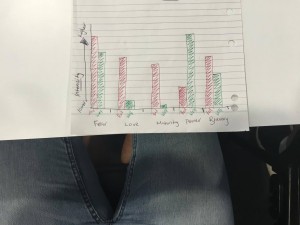
4. ???? Our own chart (Comparing the intensity of emotion of two main characters in regards to the different themes)
The main aspects I took away from this task were that story is able to be broken down into something as structured and linear as graphs because essentially it is a culmination of ideas that are categorised into different groups whether it be themes, emotional intensity or even character profiles. They all work cohesively to move the story forward. The other thing I discovered is that although in todays society we use story in a more creative and unique way, breaking it down back to its foundation will actually allow us to write are more throuough and detailed story that does not over describe or lag but actually inspires and evokes feelings from the reader.
This is lead largely by cause and effect. Without the cause for something the result of that action, dialogue or event can not take place and ultimately there will be no story. The second activity today really allowed us, in a trivial yet extremely useful way, to explore how certain locations, characters, professions, time and action effect the way a story is told. We had a bunch of different catagories and aligned them in an order that went-
Scene 1 Scene 2
Time – Place Time Place
Character – Profession – Action – Character – Profession – Action – Character – Profession
e.g
Day – Buckingham Palace Dawn – Bridge
Elizabeth – Physician – Watches T.V – Henry – Monarch – Bashfully Speaks – Holly – Bowling Alley Owner
The purpose of the above is that it gives you the basis of a story to build on. Like Queen Elizabeth a pseudo physician but Queen watches T.V with Henry who is a monarch, they see an ad about bowling and Henry decides to throw a surprise party for Elizabeth. So he meets with Holly the bowling Alley Owner. You see how (although simple) a plot is created and you have cause and effect. This essentially is the crux of all great film, novels and games (in instances). I also found this extremely useful in creating ideas for stories if you are stuck because it is a great stimulus to get creative juices flowing. Allowing un thought of ideas and storylines to pop into your head.
All in all it was beneficial in understanding the ‘rules’ if you will of story, but now it is our job to break those rules and create new and innovative ways of story telling on both a literary and trans-media platform.
Monsters and Aliens…
In class we looked at two types of stories, Frankenstein (1931) and War of the Worlds (1938). These texts helped us in finding and identifying the key points of a story.
- Plot
- Audience
- Character
- Genre
Although identifying the above may seem mainstream and junior of this type of analysis it really does give you a deeper understanding of the beginnings and foundation of a story and the impact they can have on people. All the elements of a plan are in these points. Another thing I found is the importance of a plan although I don’t have the best track record with them I think they can be very helpful in writing my own short story.
When it comes to thinking of ideas for my own short-story for next weeks assessment I was sort of confused as to what to write or how to structure it. After the readings and the sessions this week I have found that it would be easiest if I worked from a strong simple idea and let it flourish from there. There was something said this week in regards to the reader knowing that the ending of a short story was intended from the beginning of the story. The only way to achieve this is to be certain and understood within your idea.
So now all I have to do is become certain on a plot, characters and genre…
Short-Story…
Do you know the difference between a short story and a novel? Besides the obvious neither did I until today. In the words of Brander Matthews a short story “shows one action, in one place, on one day.” in comparison to a novel where there can be multiple stories, characters, settings and it can go over an extended amount of time. I found this quite intersting as I have never approached it in this way. From a background of writing for film, it is sometimes useful to write you story plot in a short and concise way. I had always had a problem with this as I found it so hard to condense so many storylines, character and timeframes into one short page or two. Now I understand why because you can’t write a good short-story if it is in fact not intended to be a short-story.
Although his views were at times racist and extreme there was one other thing Matthews brought up that really resinated with me and that was his comments on what makes a good short-story.
“If to compression, originality and ingenuity he add also a touch of fantasy, so much the better” -Brander Matthews
This emphasises the difference between a novel and a short-story and really gives the short-story its own stand alone identity. In particular, the “touch of fantasy”, obviously not meaning it in the literal sense that there needs to be magic and fire breathing dragons in every short-story but in a wider sense that the readership walk away with from the story a sense of something different that stays with them and allows them to remember the story as a stand out experience.
Reference:
Brander Matthews, The Philosophy of the Short-story, 1901, New York: Longmans, Green, and Co.
What is a story?
This week in Story Lab we spoke about story and what it is that makes story? It was concluded that story exists in many platforms and parts of all of our lives. From movies and TV shows to music and mobile applications. In film there are many aspects that make up a story and in contemporary times these aspects are much more varied than that of early times. These days stories can exist in many forms, they can be non-linear and they can transport us to other dimensions and show us what would have at one time been considered simply a fantasy or a dream. This shows us the awesome power that stories have. However, this is not to disparage the stories of earlier times. These stories although more linear and structured still had the power to effect us in the same sort of ways stories of today do. This is pinned together by the crux of a story, cause and effect. This particular story technique is what drives and is what has always driven a memorable story.
This post has merely touched on the aspects of what a story is made up of, it is in my opinion important to appreciate both classical and contemporary story because without it we would not know what the foundations of a story are. We would not know the rules to follow and of course in many instances the rules to break and change.
HELLO and Student Charter…
Welcome to my blog. I suppose the need for this blog is to assess my progress through the Bachelor of Communication (Media) course, specifically for subjects Media 5 and Networked Media. However, I hope it is more than that. I hope it allows me to explore my interests both academic and informal.
A little bit about myself. I am a 20 years old and I have just completed an Advanced Diploma of Screen and Media at RMIT TAFE. I am now in this course because there was a pathway. I am also trying to balance work and uni which is proving to be a tad difficult but achievable. Which is more likely the case for most uni students.
Linked to this post is the RMIT Student Charter, this charter outlines the values and responsibilities of the university and the students who attend it. This blog falls under this charter to uphold the outlined values and responsibilities to the RMIT community, fellow students and all members of the public. My posts I hope will reflect who I am as a person which I believe fit in to the criteria of the charter. Mostly, to be fair, respect the university and the people within it and be fully committed to my work in a and new way.
I am excited to begin this journey with myself and anyone who is willing to listen.
So here we go

